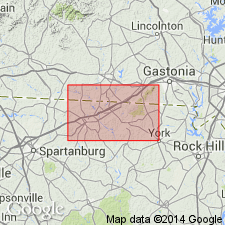
- Usage in publication:
-
- Kings Mountain quartzite*
- Modifications:
-
- Original reference
- Dominant lithology:
-
- Quartzite
- AAPG geologic province:
-
- Piedmont-Blue Ridge province
Summary:
Kings Mountain quartzite. Includes 3 distinct kinds of quartzite with gradations between them in some places (white nearly pure quartzite, kyanitic quartzite, and chlorite-sericitic quartzite grading into schist; the white quartzite normally at top), with Draytonville conglomerate member at base; apparent gradations or replacements of the conglomerate by the quartzite occur in places. Thickness of formation 5 to 500 feet. Underlies Blacksburg schist and rests unconformably on Battleground schist (Algonkian) and on Archean rocks. [Note in GNC files states that Kings Mountain quartzite is only a part of Lieber's Kings Mountain series and Sloan's Kings Mountain group, which are unnatural groupings of the rocks and abandoned here for this new and useful name.]
[Named from development on Kings Mountain, in Cleveland and Gaston Cos., western NC. Extends into northwestern SC.]
Source: US geologic names lexicon (USGS Bull. 896, p. 1100).
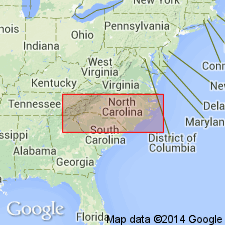
- Usage in publication:
-
- Kings Mountain group
- Modifications:
-
- Revised
- AAPG geologic province:
-
- Piedmont-Blue Ridge province
Summary:
Pg. 30-31; J.L. Stuckey, 1958, Geol. Map of North Carolina, scale 1:500,000. Rocks of Kings Mountain group consist of two parts, one of highly siliceous rock and the other largely calcareous. They are mapped as Stokes County and Kings Mountain belts. Age is Precambrian(?) or early Paleozoic(?).
[GNC remark (ca. 1960, US geologic names lexicon, USGS Bull. 896, p. 2020): The USGS currently designates the age of the Kings Mountain quartzite as Ordovician to Mississippian on the basis of a study now in progress. (See Overstreet and Bell, 1965.)]
Source: US geologic names lexicon (USGS Bull. 896, p. 2020).
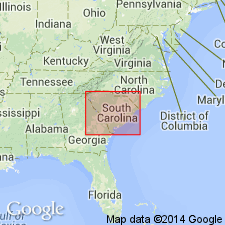
- Usage in publication:
-
- Kings Mountain Quartzite*
- Modifications:
-
- Age modified
- AAPG geologic province:
-
- Piedmont-Blue Ridge province
Summary:
Pg. 89 (geol. time scale), 109. Kings Mountain Quartzite. Age changed from Cambrian --to-- Ordovician to Mississippian. (Authors follow revised time scale of Holmes, 1959, Edinburgh Geol. Soc. Trans., v. 17, pt. 3, p. 183-216.)
Source: Publication; Changes in stratigraphic nomenclature, 1964 (USGS Bull. 1224-A, p. A19).
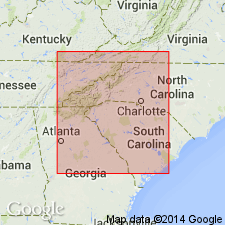
- Usage in publication:
-
- Kings Mountain Quartzite
- Modifications:
-
- Not used
- AAPG geologic province:
-
- Piedmont-Blue Ridge province
Summary:
Kings Mountain Quartzite included on list of formal rock-stratigraphic units within the Kings Mountain belt that have been avoided or used with discretion because of various problems. According to authors, quartzites that Keith and Sterrett (1931) mapped as Kings Mountain are also found within rocks they mapped as Blacksburg Schist and within those they mapped as Battleground Schist.
Source: GNU records (USGS DDS-6; Reston GNULEX).
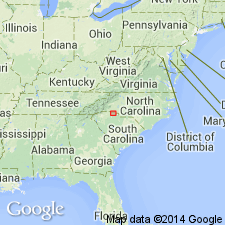
- Usage in publication:
-
- Kings Mountain Quartzite†
- Modifications:
-
- Abandoned
- AAPG geologic province:
-
- Piedmont-Blue Ridge province
Summary:
Kings Mountain Quartzite abandoned and its Draytonville Conglomerate Member redefined as Draytonville Metaconglomerate Member of the Battleground Formation. Quartzites and conglomerates previously mapped as Kings Mountain occur at several stratigraphic positions within the Battleground and Blacksburg Formations and are assigned to them.
Source: GNU records (USGS DDS-6; Reston GNULEX).
For more information, please contact Nancy Stamm, Geologic Names Committee Secretary.
Asterisk (*) indicates published by U.S. Geological Survey authors.
"No current usage" (†) implies that a name has been abandoned or has fallen into disuse. Former usage and, if known, replacement name given in parentheses ( ).
Slash (/) indicates name conflicts with nomenclatural guidelines (CSN, 1933; ACSN, 1961, 1970; NACSN, 1983, 2005, 2021). May be explained within brackets ([ ]).

